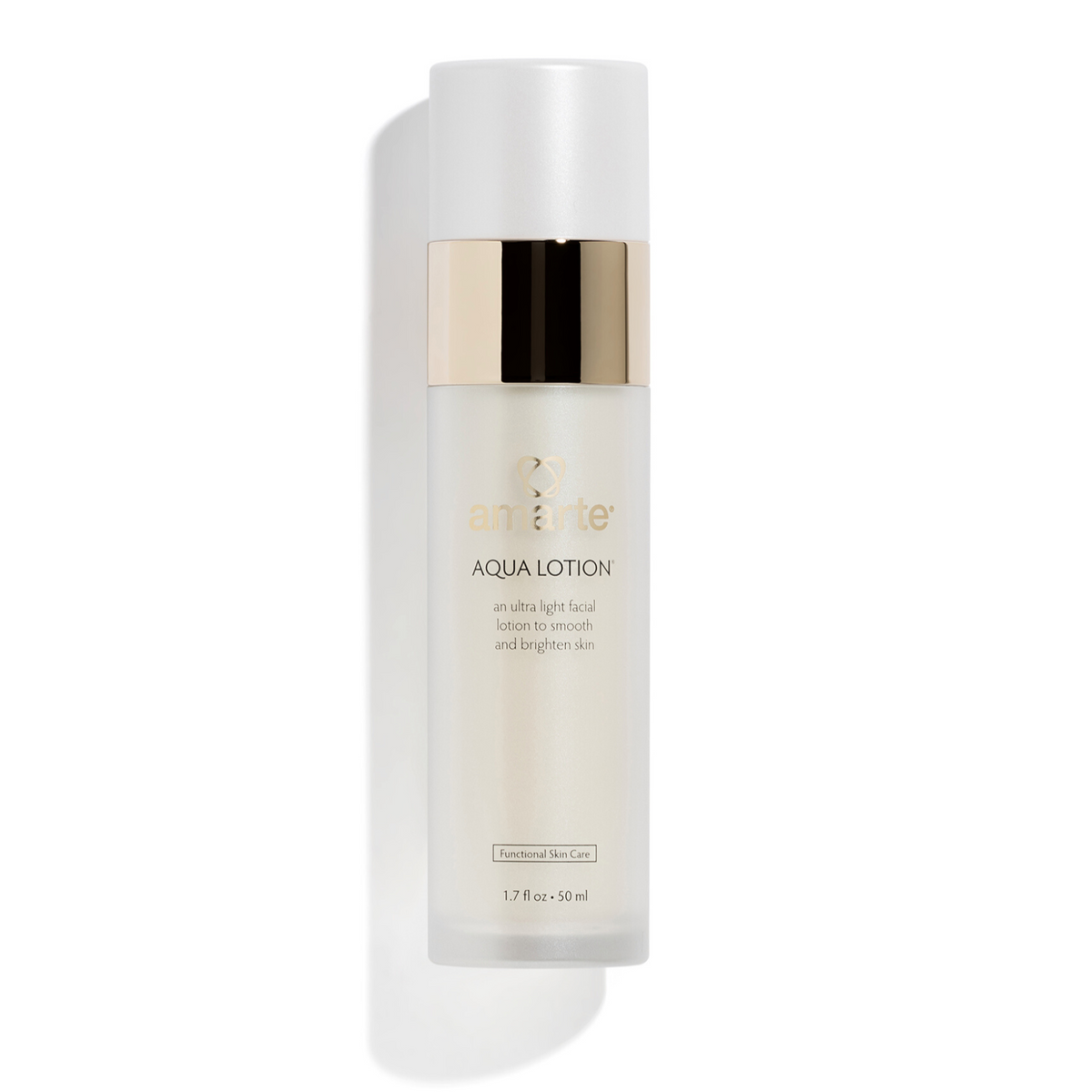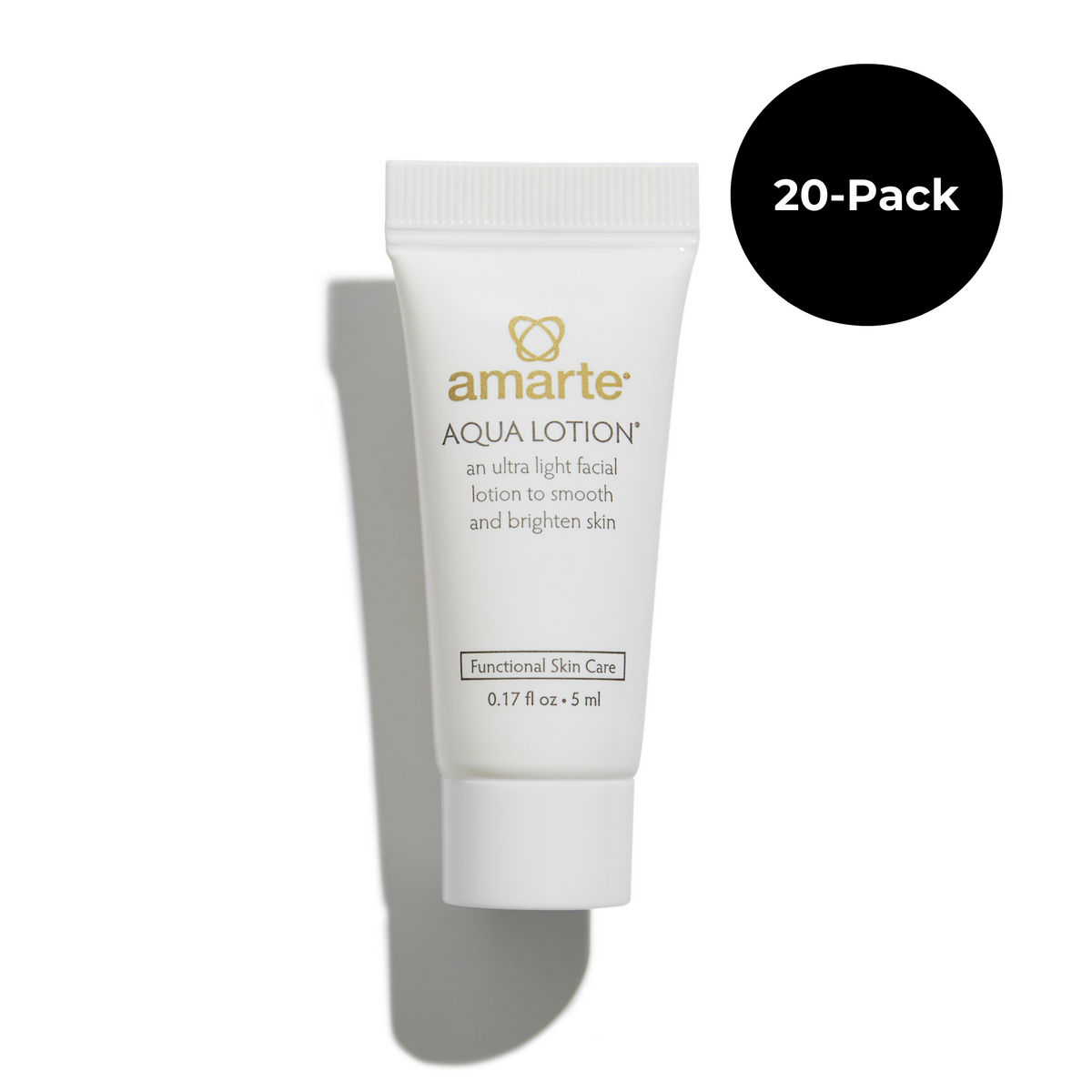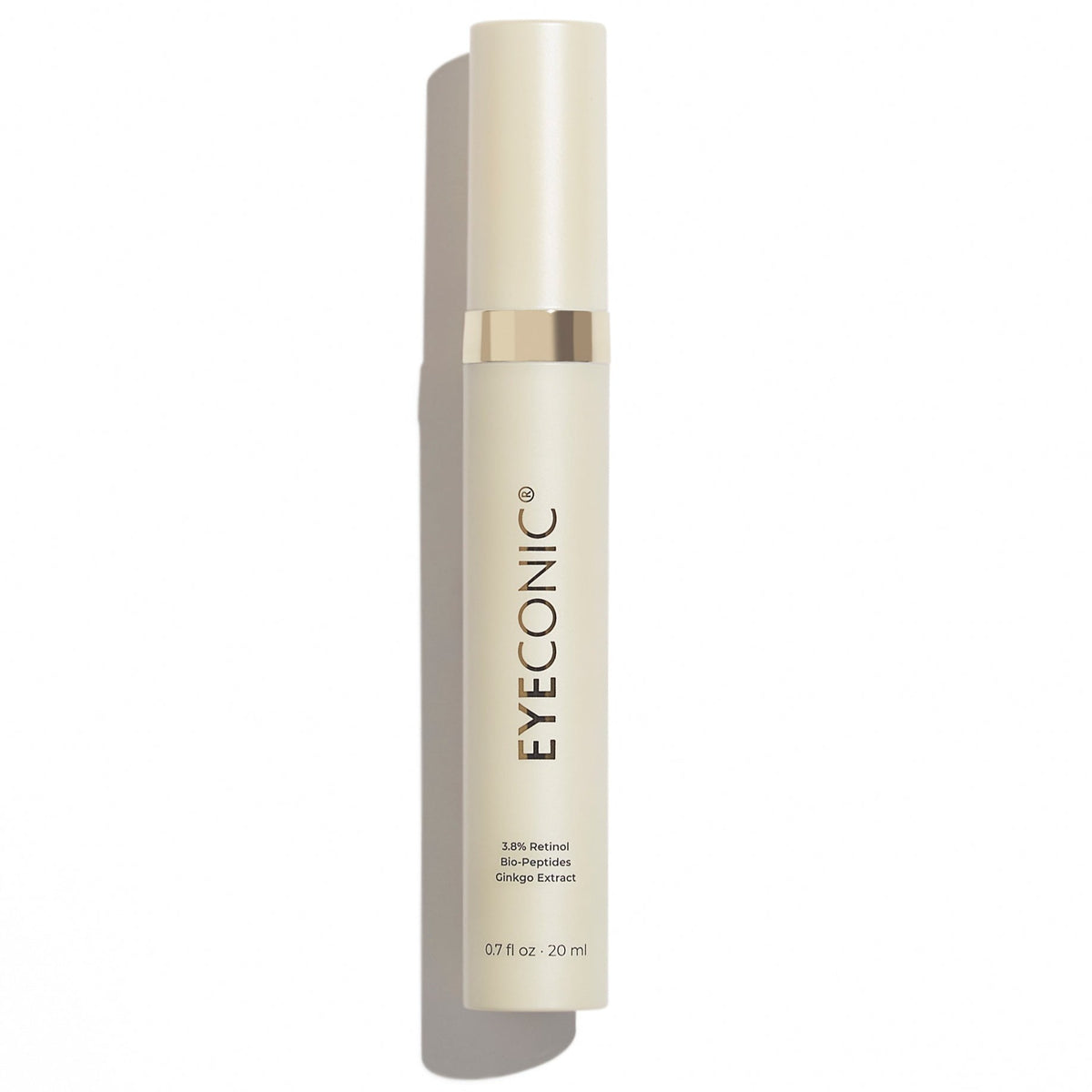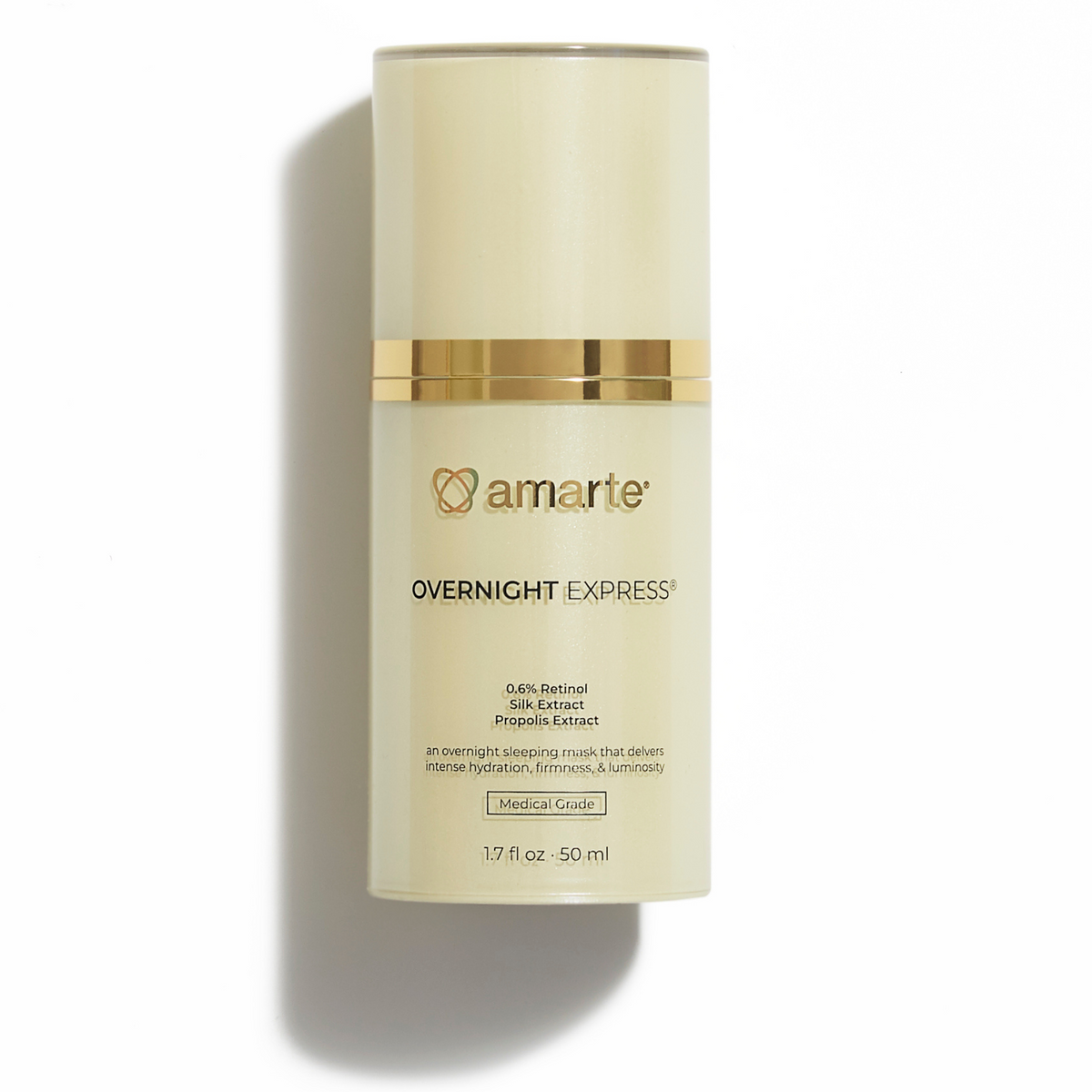AQUA LOTION®
Brightening Lotion
- Regular Price
- $55.00
- Sale Price
- $55.00
- Regular Price
- Unit Price
- Translation missing: en.general.accessibility.unit_price_separator
Arbutin
Arbutin is a skin conditioner with whitening, antioxidant, anti-inflammatory, and antibacterial properties. Derived from blueberries, bearberries, cranberries, and pears, arbutin inhibits melanin formation via tyrosinase inhibition resulting in cosmetically relevant whitening properties.
– antioxidant – brightens, calms.
Purified Nano-Sulfur
Elemental sulfur is a periodic table element that is an essential part of all living organisms. A broad spectrum antimicrobial with unique anti-inflammatory and exfoliative properties, purified elemental sulfur is very effective in the treatment of acne, rosacea, and seborrheic dermatitis. A multi-tasker, this element is also a skin brightener that helps decrease sebum production. Amarte uses two nanometer diameter pure sulfur particles to create revolutionary efficacy and cosmetic elegance.
brightens, purifies, soothes.
Allantoin
Allantoin is a botanical extract said to be healing, calming, and soothing. An excellent temporary anti-irritant, allantoin helps protect skin from external factors such as wind burn and may aid in healing damaged skin by stimulating new tissue growth. It is appropriate for sensitive, irritated, and acne-prone skin and is non-sensitizing. It may be synthesized or derived from the comfrey root.
Heals, calms, soothes.
-
water
Water is a fundamental ingredient for skin care products and life itself. Amarte products contain spring water sourced from a Korean nature preserve.
-
glycerin
Glycerin is a clear syrupy liquid made by chemically combining water and lipid derived from vegetable oil. Used as a humectant in moisturizers, glycerin is a water-binder that is able to draw and absorb water from the air, thus helping skin retain moisture. It facilitates exfoliation-promoting enzymatic reactions within skin and improves spreading qualities of creams and lotions.
-
arbutin
Arbutin is a skin conditioner with whitening, antioxidant, anti-inflammatory, and antibacterial properties. Derived from blueberries, bearberries, cranberries, and pears, arbutin inhibits melanin formation via tyrosinase inhibition resulting in cosmetically relevant whitening properties.
-
Argania spinosa (argan) kernel oil
Argan oil is an emollient and skin conditioner derived from the nut of the argan tree. Native to Morocco, the argan tree lives up to 200 years and its oil has been used for skin care and dietary supplementation for centuries. It is rich in tocopherol (vitamin E), phenolic acid, carotenes, and essential fatty acids including omega-9 oleic acid and omega-6 linolenic acid. Considered beneficial in managing dry skin, eczema, psoriasis, acne, and sunburn, argan oil is one of the rarest oils in the world.
-
caviar extract
Caviar extract is prepared from sturgeon roe and used in products for oily and mature dehydrated skins requiring revitalization. It is rich in unsaturated fatty acids and boasts a high content of multiple vitamins, including A, B1, B2, B6, D, and E. Caviar extract also contains minerals such as cobalt, copper, iodine, iron, magnesium, manganese, phosphorus, silicium, and zinc, as well as multiple essential and sulfured amino acids, including glutamic acid, glycine, methionine, lysine, arginine, histidine, and aspartic acid.
-
beeswax
Beeswax, derived from virgin bees, is one of the oldest raw ingredients used in cosmetic preparations. Essentially insoluble in water, beeswax is used in many skin care creams and cosmetics as an emulsifier of water-in-oil emulsions and regulates formulation consistency. It forms a lipid network rather than a film and is non-scientifically credited with anti-inflammatory, anti-allergic, antioxidant, antibacterial, germicidal, skin-softening, and elasticity-enhancing properties.
-
allantoin
Allantoin is a botanical extract said to be healing, calming, and soothing. An excellent temporary anti-irritant, allantoin helps protect skin from external factors such as wind burn and may aid in healing damaged skin by stimulating new tissue growth. It is appropriate for sensitive, irritated, and acne-prone skin and is non-sensitizing. It may be synthesized or derived from the comfrey root.
-
elemental sulfur
Elemental sulfur is a periodic table element that is an essential part of all living organisms. A broad spectrum antimicrobial with unique anti-inflammatory and exfoliative properties, purified elemental sulfur is very effective in the treatment of acne, rosacea, and seborrheic dermatitis. A multi-tasker, this element is also a skin brightener that helps decrease sebum production. Amarte uses two nanometer diameter pure sulfur particles to create revolutionary efficacy and cosmetic elegance.
-
adenosine
Adenosine is an essential amino acid. This white crystalline powder is isolated by hydrolysis of yeast nucleic acid and boasts proven anti-wrinkle and skin-smoothing capacities.
-
Ginkgo biloba nut extract
Ginkgo biloba nut extract is found exclusively in Amarte Skin Care products. Ginkgo fruit has a unique odor and is resistant to smoke, disease, and insects. Derived from the fruit of the Ginkgo nut utilizing Amarte's patented machinery and methods, this extract is derived from the portion of the Ginkgo tree believed to be richest in active ingredients. Ginkgo biloba nut extract has antioxidant and possible anti-inflammatory properties. It appears to aid fibroblast production of collagen and elastin and exerts protective effects on vascular walls. Its beneficial properties are attributed to various flavonoids, including quercetin, kaemphferol, and ginkgetin. Its key constituents also include ginkgolide and bilobalide, catechin, tannin, and luteolin.
-
hydrogenated lecithin
Hydrogenated lecithin is a emulsifier and surfactant commonly found in skin care products. It has been scientifically studied by Korean university professors and found to to be ideally suited for use in safe and uniquely elegant skin care nanoemulsions.
-
Chamomilla recutita (chamomile) flower extract
Chamomilla recutita (chamomile) flower extract is an aqueous-alcoholic extract prepared from flower heads of the aromatic chamomile plant. Its active components include azulene, bisabolol, and phytosterol, and it is known for its anti-inflammatory and reparative properties.
-
trehalose
Trehalose is a disaccharide plant sugar humectant comprised of two linked glucose molecules. It possesses uniquely beneficial moisture retention properties that have been shown to help prevent cellular damage in the event of dehydration.
-
Rosmarinus officinalis (rosemary) extract
Rosmarinus officinalis (rosemary) extract is a potent antioxidant extract derived from the leaves of the garden rosemary plant. Possessing astringent, toning, refreshing, deodorant, antiseptic, softening and invigorating properties, this extract adds fragrance to a formulation and its active components include several amino acids, caffeic acid, rosemary acid and apigenin.
-
Hamamelis virginiana (witch hazel) leaf extract
Hamamelis virginiana (witch hazel) leaf extract is an extract from the American witch-hazel tree with astringent and skin conditioning properties. It was first used by early New England settlers for its anti-inflammatory and anti-tumor properties.
-
Aspalathus linearis extract
Aspalathus linearis extract is derived from antioxidant and phenolic compound rich leaves of a broom-like red bush from South Africa. Often called rooibos, this plant’s leaf extract contains quercetin and luteolin which are reported to have anti-cancer properties.
-
dimethicone
Dimethicone is an inert, non-toxic silicone oil that serves as a skin protectant, provides lubricity and is very useful in reducing greasiness while improving water-resistance in SPF formulations.
-
Helianthus annuus (sunflower) seed oil
Helianthus annuus (sunflower) seed oil is a noncomedogenic oil with antioxidant and smoothing properties that is rich in vitamin E. It serves as a skin protectant that helps skin retain moisture. Daily application has been shown to decrease the risk of skin infections.
-
polyacrylamide
Polyacrylamide is an organic polymer that creates a thin water-binding film surface skin film. This water retaining film helps ensure rich hydration without oiliness or detectible residue.
-
C13-14 isoparaffin
A mixture of long chain organic compounds that functions as an emollient and formulation thickener.
-
palmitic acid
Palmitic acid is the most common fatty acid found in nature. It possesses mild antioxidant properties and is used in skin care products primarily for emulsifying and emollient purposes.
-
glyceryl stearate SE
Glyceryl stearate SE is a self-emulsifying form of glyceryl sterarate containing a small amount of sodium and/or potassium stearate. Glyceryl stearate is a mixture of mono-, di-, and triglycerides of palmitic and stearic acids. Synthesized from glycerin and stearic fatty acids, glyceryl stearate is derived for cosmetic use from palm kernel or soy oil and serves as an emulsifier that assists in forming neutral stable emulsions. It is also a solvent, humectant and consistency-regulator in water-in-oil and oil-in-water formulations. This skin lubricant imparts a pleasant feel.
-
polyglyceryl-3 methylglucose distearate
Polyglyceryl-3 methylglucose distearate is a plant-based emollient, surfactant, and emulsifier.
-
C12-16 alcohols
C12-16 alcohols is a mixture of synthetic fatty alcohols with 12 to 16 carbons in the alkyl chain. It is used as an emulsifier, emollient, and thickener and is considered completely safe.
-
polysorbate 60
Polysorbate 60 is a condensate of sorbitol with stearic acid and is a waxy substance that is soluble in solvents. Serving as an emulsifier, wetting agent, and detergent emulsifier for mineral oil, fats, and waxes, polysorbate 60 is widely used in cosmetic preparations.
-
laureth-7
A non-comedogenic low-viscosity surfactant and emulsifier derived from coconut oil.
-
phenoxyethanol
Phenoxyethanol is a viscous, oily, liquid preservative with a faint rose-like scent. It has been extensively studied by the United States FDA and the Consumer Federation of America-backed Cosmetic Ingredient Review (CIR) Expert Panel on two occasions, including most recently in 2007. Consensus scientific data assessments have confirmed its safety as a cosmetic ingredient; the European Union Cosmetics Directive concurs with this safety assessment. Phenoxyethanol prevents or suppresses microbial growth and thus protects cosmetics and skin care products from spoilage. It is also used in fragrances.
-
Caprylic/capric triglyceride
Caprylic/capric triglyceride is an emollient with valuable spreading properties derived from coconut oil that promotes product absorption without leaving an oily residue on the skin.
HOW TO USE: Dispense a dime-sized amount of product to your fingertips and apply to face, neck, and décolleté, gently massage into skin until absorbed.
WHEN TO USE: Use after your hydrating mist and/or serum to seal in moisture and brighten in the morning, evening and as often as desired.
*Moisturizing seals in moisture (this is why adding a hydrating step is so beneficial for your skin) to strengthen your skin’s natural protective barrier. This will prevent water loss so skin remains soft and smooth.













